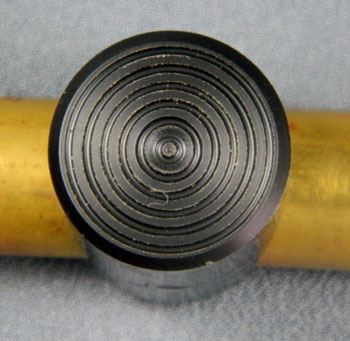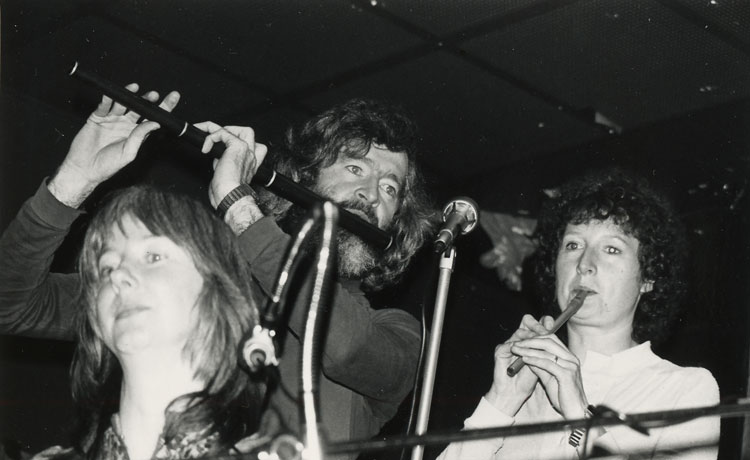Introduction
OK, let's face it. I'm
getting old. 68 years old as at 1 Jan 2015. And with age
comes the drawbacks of age, in my case, arthritis. I've already
had two knees replaced (with spectacular success, and thanks to
Australia's excellent public health arrangements, at no cost to me).
But recently the joints at the base of my thumbs have started giving me
trouble. Particularly when holding thin things for a while.
Tin whistles are thin. And I like to hold them for a while.
It's all that Mary Bergin's fault.*
So, I got to wondering what I
could do about it. A thicker tin whistle perhaps? Or, Aha!
Make a thin tin whistle thicker? That shouldn't be hard.
Experiment
So, time for a simple
experiment. I cut a piece of pine to 20mm (3/4") square and long
enough to cover the holes on the whistle while leaving 20mm overhang at
both ends. Then, using plastic insulation tape, I taped the two
ends to the back of the whistle, making sure to keep the finger-holes
uppermost.
That worked really well,
keeping my thumbs at about their preferred distance from my first
fingers. No pain, even after a lot of playing. And the
greater depth and flat surface increased the surety of grip remarkably.
Appearance? Hmmm, perhaps those sorts of words are best reserved
for the public bar.
Criteria
So, what should a real one
look like? I thought of these criteria:
-
Probably a little thinner
from the back of the whistle to the thumb surface than my piece of
pine
-
Flat at the back. I
found it really nice to have my thumbs on a flat surface rather than the
narrow slippery roundness of the whistle.
-
Less obvious. I don't
want to attract excessive sympathy. Well, not quite yet,
anyhow....
-
Adjustable. I thought it
would possibly be useful to be able to tilt the thumb surface in respect to
the tube.
-
Variable. I'm not sure that
both thumbs agree on the ideal thickness. Why should they?
-
Moveable. Finding the exact
position would be a matter of trial and error. Conceivably, one might feel
the need to move them from time to time.
-
Stable. Of all things,
they must not introduce instability. Ideally, they will reduce it.
And that means
-
Tight. Once set,
forget.
-
Separate. All that suggests
better to have one for each thumb, than just one for both.
Prototypes
I made the prototypes from 3/4"
(20mm) delrin rod (actually 20.4mm in my case). My whistle being 14.3mm in
diameter (13.6mm bore), I decided that a hole through the rod at 14mm diameter
should give the right balance of tightness and moveability, and that seems to
have been a good choice. Having bored the holes, I cut the rod off at the
top of each hole and at the desired overall length, faced top and bottom in the
lathe and chamfered them at the non-controversial angle of 45º. This
ensured that my flying fingers do not contact the tops of the buttons while
playing. (A collision at that speed could end up punching a hole in the
space-time continuum, scattering the stage with Higgs Boson particles.)

(For the techies out there, I
approached boring the 14mm holes in a characteristically lazy way. I held
the short lengths of rod sideways in the 3-jaw chuck, so that two jaws nipped
the side of the rod, while the third nipped the top. Then bored a pilot
hole and followed up with a boring bar. That gave me fine control over the
final diameter of the hole.)
Installing the buttons requires
stretching the delrin from 14mm to 14.3mm, not difficult given the open end.
But this makes it much easier. Insert the end of the tube into the hole at
an angle, as if using the tube to separate the open ends at the top of the
button. Now rotate the button so its hole is inline with the tube and it
will just slide nicely on.
And the outcome?
Really good. The buttons are
easy to install and slide to position, and totally stable once there.
Finding the ideal location is dead easy - it seems we are not too fussy about
where our thumbs go. The flat backs are really comfortable and reassuring
to the thumbs, but I can still rotate the whistle when I want to play a
half-holed Cnatural. And it's easier to pick up and doesn't roll off the
table!

Improved traction
Some several weeks after
making them, we had a burst of really hot, sticky weather. That
can happen on the coast in the heights of summer! And
naturally, one's hands get a little sweaty under those conditions, and I
found the smooth surface at the bottom of the Delrin buttons getting a
little slippery. The same could happen on stage, under hot lights.
So it struck me a little
improvement would be to add a series of little grooves to the bottom of
each button. I did that using a lathe tool set at 45º, just
allowing the tool to cut about 0.5mm deep.
Big improvement. Much
better traction (I did one button first and compared thumbs.), but no
sense of roughness or reduction in comfort.
Will they help me?
Of course, I can't tell that. But you can repeat the
simple experiment further up, and if that feels better, then I reckon they
will help. And they might help for conditions other than arthritis.
For example, any condition that makes holding the whistle tricky will
probably be helped by having a flat surface rather than a round tube to
hold.
And where can I get 'em?
At this stage, I don't know. I'm certainly not planning to
make them - I have enough on my plate already! But anyone with a lathe
could probably do it from the description above. I'll mention the idea
around and see if anyone is interested in making them. Heh heh, maybe
somebody already is!
*All Mary Bergin's fault?
Not the arthritis, just the whistle. I'd taken up playing
whistle in Australia, but with no guidance, and not even much access to good
recordings, it was more in the Australian bush band style. When we got to
Dublin in 1974, we headed straight to the Tradition Club, in Slattery's bar in
Capel Street, on the advice of an old chap we'd met in London, name of Seamus
Ennis. First night we were there, Mary Bergin played, and I was gobsmacked.
I asked her afterwards where does one learn to play like that, and she said:
"Well I teach". Things were looking up. We only had a few months in
Dublin, but it made quite a difference! Some tens of years later,
Mary visited Canberra, and we had the pleasure of playing with her at a night of
Irish Music in the old Civic pub:

Margaret Canny, Terry McGee and Mary Bergin, Civic Pub,
Canberra. 22 May, but what year? (Margaret Canny,
pictured left above is the younger daughter of the late Jack Canny, brother of
legendary Clare fiddle player, Paddy Canny. Margaret is also a lovely
whistle player.) |